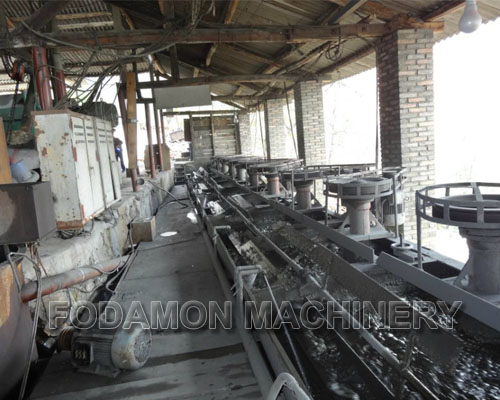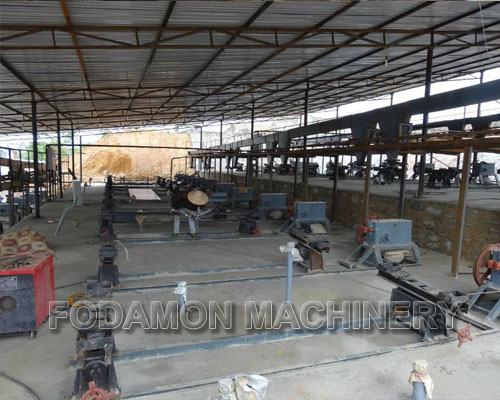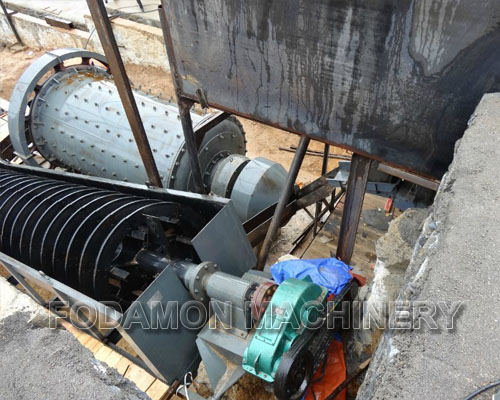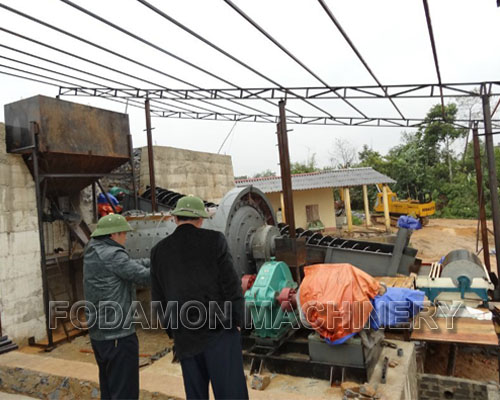Manganese ore processing has many processes, such as magnetic separation, flotation, gravity separation and so on. In actual production Fodamon adopt, the simple and easy-to-concentrate manganese ore mostly adopts magnetic separation process, while the difficult-to-concentrate manganese ore often needs a combination of various mineral processing processes and a combined mineral processing process.
(1) Beneficiation of manganese ore
Most manganese ores belong to lean ores and must be treated by beneficiation. However, because most manganese ores are fine or fine-grained, and there are a considerable number of high-phosphorus ores, high-iron ores and common (associated) beneficiary metals, it brings great difficulties to mineral processing. At present, the commonly used beneficiation methods of manganese ore are mechanical separation (including washing, screening, gravity separation, high intensity magnetic separation and flotation), pyrometallurgical enrichment, chemical beneficiation and so on.
- Washing and screening
Ore washing is to separate ore from mud by hydraulic flushing or additional mechanical scrubbing. Common equipment includes washing screen, cylinder washer and trough washer.
Ore washing operations are often accompanied by screening, such as washing directly with water on the vibrating screen or sending the ore sand (clean ore) obtained by the washing machine to the vibrating screen. Screening can be used as an independent operation to separate products of different sizes and grades for different purposes. - Gravity separation
At present, gravity separation is only used for separating manganese ores with simple structure and coarse particle size, especially for manganese oxide ores with high density. The common methods are heavy medium beneficiation, jigging beneficiation and shaking bed beneficiation.
At present, the technological process of treating manganese oxide ore in our country usually breaks the ore to 6-0 mm or 10-0 mm, then divides the ore into groups, jigs the coarse grade and shaker the fine grade. The equipment is mostly Hazi reciprocating jig and 6-S shaker. - High intensity magnetic separation
Manganese mineral is a weak magnetic mineral [specific susceptibility X=10×10-6~600×10-6cm3/g], and can be used in a strong magnetic field magnetic separator with magnetic field strength Ho=800~1600kA/m (10000~20000oe). When recovered, it can generally increase the manganese grade by 4% to 10%.
Because of the simple operation, easy control and strong adaptability of magnetic separation, it can be used in the selection of various manganese ores. In recent years, it has dominated the manganese ore dressing. Various new types of coarse, medium and fine grain magnetic machines have been successfully developed. At present, the most common application of manganese ore in China is the medium-grain strong magnetic separator. The coarse-grained and fine-grained magnetic separators are gradually being applied. The micro-grain-strong magnetic separator is still in the experimental stage. - Gravity-magnetic separation
At present, the newly built and rebuilt heavy-magnetic separation plants in China include Liancheng, Fujian, Longtou, Jingxi and Xialei manganese ores. For example, Liancheng Manganese Mine Gravity-Magnetic Separation Plant mainly deals with leaching manganese oxide ores, and uses AM-30 jig to treat 30-3mm washing ores. High-quality manganese concentrate containing more than 40% manganese can be obtained. After manual separation, it can be used as raw material for battery manganese powder. The grade of manganese concentrate should be increased by 24%-25% to 36%-40% when the jigging tailings and the washing diameter less than 3 m m are milled to less than 1 m by high intensity magnetic separator. - High-intensity Magnetic-flotation
At present, only Zunyi manganese ore is used in high-intensity Magnetic-flotation process. The ore is a low manganese, low phosphorus and high iron manganese ore dominated by manganese carbonate.
According to the industrial test, the grinding process adopts rod mill-ball mill stage grinding, and the equipment scale is φ2100mm×3000mm wet grinder. High-intensity magnetic separation uses shp-2000 high-intensity magnetic machine, flotation machine mainly uses CHF inflatable flotation machine. After many years of production, it has good performance and is very suitable for the application of Zunyi manganese ore dressing. The successful test of high intensity magnetic flotation process and its application in production indicate that the deep separation of manganese ore in China has made a great step forward. - Fire enrichment
The pyrometallurgical enrichment of manganese ores is a separation method for treating refractory low-grade manganese ores with high phosphorus and high iron. It is generally called manganese-rich slag method. Its essence is a high temperature separation method for selective separation of manganese, phosphorus and iron by controlling the reduction temperature of manganese, phosphorus and iron in blast furnace or furnace.
China has been using fire law for nearly 40 years. In 1959, Hunan Shaoyang Zijiang Iron Works was tested on a 9.4m3 small blast furnace and obtained preliminary results. Subsequently, in 1962, Shanghai Ferroalloy Plant and Shijingshan Iron and Steel Plant smelted manganese-rich slag in the blast furnace. In 1975, the manganese blast furnace in Manushan, Hunan Province not only produced manganese-rich slag, but also recovered lead, silver and pig iron (commonly known as semi-steel) at the bottom of the furnace, providing a basis for comprehensive utilization. After entering the 1980s, the production of manganese-rich slag has developed rapidly. The production of manganese-rich slag has been developed in Hunan, Hubei, Guangdong, Guangxi, Jiangxi, Liaoning, and Jilin.
The enrichment process of fire method is simple, the production is stable, and the iron and phosphorus in the ore can be effectively separated to obtain manganese-rich, low-iron, low-phosphorus manganese-rich slag, and the manganese-rich slag generally contains Mn 35% to 45%. Mn/Fe12~38, P/Mn<0.002, is a high-quality manganese-based alloy raw material, and it is also an artificial rich ore that is difficult to achieve the above three indexes at the same time. Therefore, the enrichment of fire method is a promising method for mineral processing in China for high-phosphorus high-iron and low-manganese refractory ore. - Chemical Separation of Manganese
There are many chemical beneficiations of manganese, and a lot of research work has been done in our country. Among them, there are many experiments, and the most promising ones are dithionate method, black manganese ore method and bacterial leaching manganese method. At present, it has not been put into industrial production.
(2) Manganese ore powder building block
The pelletizing process includes sintering, pelletizing and pressing. At present, sintering method is mostly used in lumping in China. Only when the manganese concentrate or powder ore is very fine, and – 200 mesh is above 80% and the residual carbon in the product is not allowed, pellets or pellets are used.
In the early 1950s, sintering pot sintering and soil sintering were mostly used for manganese ore powder in China. With the development of iron and steel production, soil sintering can not meet the requirements, so many sintering machines or other efficient lumping equipment have been built. In 1970, the first sintering machine for fine manganese ore (18m2) was built and put into operation in Xiangtan Manganese Mine. In 1972, two 24m2 sintering machines were built in Xinyu Iron and Steel Works of Jiangxi Province. In 1977, the first 80m2 belt roaster for manganese concentrate pellets was built and put into operation in Zunyi Manganese Mine. In the 1980s, Xiangtan Manganese Mine, Bayi Manganese Mine and Xiangxiang Ferroalloy Plant successively built more than 18-24 m2 sintering machines, and Shanghai Ferroalloy Plant introduced balling equipment as powder ore lumping.
The development of lumping technology has brought more economic benefits to the smelting of manganese alloys. Taking Jiangxi Xinyu Iron and Steel Works as an example, the blast furnace smelting technical index can be greatly improved by increasing the clinker ratio and replacing hot sinter with cold-fired ore.
(3) Manganese ore smelting
Manganese ore smelting products mainly include high carbon ferromanganese, medium and low carbon ferromanganese, manganese-silicon alloy and metal manganese, commonly known as manganese alloys or manganese series alloys.
High carbon ferromanganese. BF is mainly used in China. In the 1950s, no special manufacturer was formed to produce blast furnace ferromanganese (high carbon ferromanganese). Instead, some iron and steel factories were self-refining and self-selling, and their production was very small. Since 1958, Xiangtan Manganese Mine has built 6.5m3 and 33m3 blast furnaces specializing in ferromanganese smelting. After the 1960s, Xinyu, Yangquan, Maanshan Iron and Steel Works and Chongqing Iron and Steel Works have converted to ferromanganese in blast furnaces. In the 1980s, the development of ferromanganese in blast furnaces has been faster. The output of ferromanganese in blast furnace increased from 200,000 tons in 1981 to 400,000 tons in 1995.
The products produced by electric furnace include carbon ferromanganese, medium and low carbon ferromanganese, manganese-silicon alloy and metal manganese. The earliest electric furnace production in our country is Jilin Ferroalloy Plant, which was built and put into operation in 1956 with a maximum capacity of 1250 kVA. In the early 1960s, Hunan, Zunyi and Shanghai Ferroalloy factories were built and put into operation one after another. These factories can produce ferromanganese, medium and low carbon ferromanganese and manganese-silicon alloys. Zunyi Ferroalloy Plant also produces metal manganese by electro-silicothermic method. According to the 1995 “Main Technical and Economic Indicators of Ferroalloys in China” of the Ministry of Metallurgical Industry, 11 of the 15 key Ferroalloy factories in 1994 produced manganese series alloy products. Through continuous development and expansion, these key ferroalloy plants have made important contributions to satisfy the production of iron and steel industry.
Since the 1980s, local small and medium-sized ferroalloy enterprises have developed rapidly. According to statistics, the proportion of ferroalloy production of local small and medium-sized enterprises in China rose from 32.39% in 1980 to 54.01% in 1989, to 69.85% in 1996, and the number of enterprises reached more than 1000. Most of these small and medium-sized enterprises are small electric furnaces with 1800 kVA. The equipment is backward and the product quality is poor.
Electric furnace ferromanganese and silicon manganese alloy production equipment used is basically the same, are all using ore-thermal furnace, furnace transformer capacity is generally 1800-12500 kVA. Hunan and Zunyi ferroalloy plants have imported 3000 kVA and 31500 kVA Silicon-manganese electric furnaces from Germany, respectively, and they have been put into operation.
The production of high carbon ferromanganese in electric furnaces in China usually adopts flux process. Slag process is generally used in the production of manganese-silicon alloy.
The production of medium and low carbon ferromanganese mainly includes electric furnace method, oxygen blowing method and shaking ladle method. The shaking ladle process includes the direct production of low carbon ferromanganese in the shaking ladle and the shaking ladle-electric furnace process for the production of low carbon ferromanganese. The process of shaking bag-electric furnace is advanced, stable in production and good in technology and economy. At present, this method is used in Shanghai, Zunyi and other ferroalloy factories.
The production methods of metal manganese include pyrometallurgy and hydrometallurgy. The pyrometallurgical smelting of manganese metal started in 1959 in China. It was first successfully manufactured by electro-silicothermic method in Zunyi Ferroalloy Plant and has been exclusively manufactured up to now. The production process adopts three-step method, the first step is to use manganese ore to produce manganese-rich slag, the second step is to use manganese-rich slag to produce high silicon Silicon-manganese alloy, the third step is to use manganese-rich slag as raw material, high Silicon-manganese as reductant and lime as flux, that is, to produce metal manganese by electrosilicothermal method. Hydrometallurgy is mainly electrolysis, often called electrolytic manganese metal. In 1956, China built the first electrolytic manganese plant from Shanghai 901 plant. By the early 1990s, there were more than 50 large and small electrolytic manganese plants, with an annual total production capacity of more than 40,000 tons. The production process can be roughly divided into three production processes: preparation of manganese sulfate solution, electrolysis and post-treatment. Post-treatment is a series of operations including product purification, washing, drying, peeling and packaging after electrolysis. Finally, qualified electrolytic manganese products containing 99.70%-99.95% Mn were obtained.




